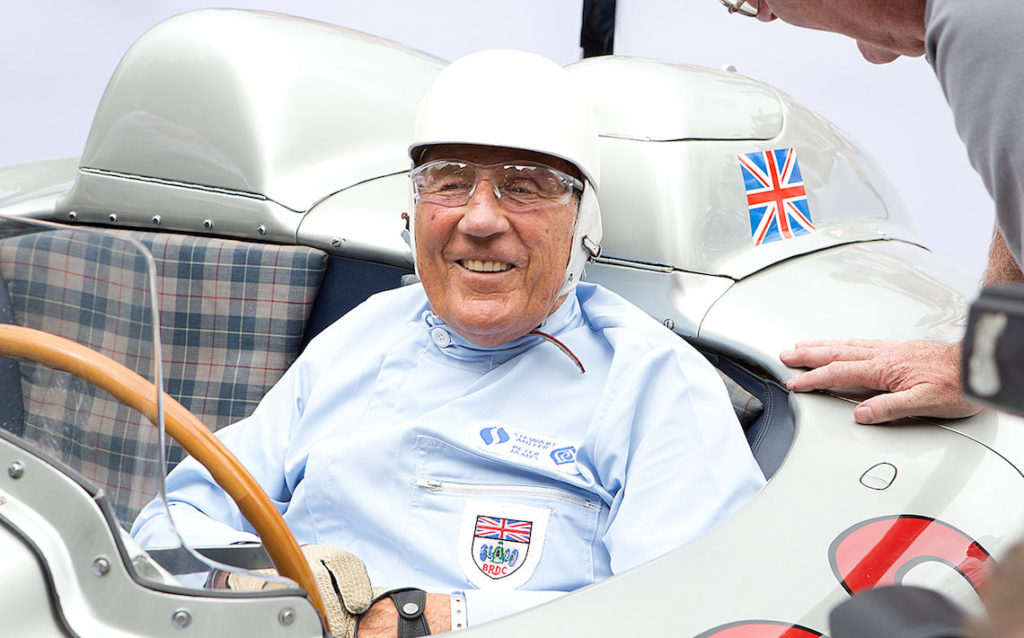A Formula 1 season already delayed indefinitely by the Coronavirus pandemic suffered another heavy blow on Sunday as the legendary British motoring ace, Sir Stirling Moss, passed away peacefully at his London home at the age of 90. The New York Times obituary is here.

Photo courtesy The Sunday Times DRIVING section
Widely considered to be one of the best racers of his or any other era, with some rating him second only to Juan Manuel Fangio in Formula 1’s golden decade of the 1950s, Moss won 16 Grand Prix and had 24 podiums between 1951 and 1961 but never managed to win the title. Moss famously defended his chief rival for the 1958 Championship, countryman Mike Hawthorn, from the stewards’ wrath after Hawthorn’s unorthodox recovery maneuvers following a spin during the Portuguese GP. That sporting gesture, not altogether dissimilar to Peter Collins handing over his car to Fangio at Monza in 1956 to enable the Argentinian great to win that year’s Championship, allowed Hawthorn’s second place points to stand. So despite winning four Grand Prix to Hawthorn’s one victory that season, including that fateful Portuguese contest, Moss was edged out by Hawthorn for the 1958 title by a single point. It is also widely acknowledged that Moss’s steadfast desire to race British cars in F1 most likely cost him other championships, as they were often inferior to their Italian or German competition during that era. But that same stubborn nationalism earned him a fanatically loyal and adoring following in Great Britain that remains to this very day. If you’re looking for Britain’s top heroes in their national psyche there is Churchill, James Bond and Moss.
A prolific winner in other classifications of motorsport at a time when the world’s top drivers tended to compete in nearly every high level event, Moss was also victorious at 1956’s 24 Hours of Le Mans driving an Aston Martin DB3S along with Collins and owner David Brown; he had two overall victories at the 12 Hours of Sebring in 1954 and 1957; and a 12 Hours of Reims win in 1953. Perhaps most famously, Moss and co-driver/navigator, the revered racing journalist Denis Jenkinson, took the overall victory in 1956 at the always treacherous Mille Miglia while piloting the stunning Mercedes-Benz 300 SLR. That victory, chronicled by jenkinson in the seminal motorsport article “With Moss In the Mille Miglia” was made all the sweeter in that it came at the expense of the second place Fangio, who so frequently bested Moss in Formula 1 for the ultimate prize — the Drivers’ Championship — throughout the 1950s. To attest to the Mille Miglia’s extreme difficulty, that was not only Moss’s only victory in six attempt during the decade but also his only finish. Additionally, he set several speed records in the ’50s, most notably a two-lap average of 245.64 mph at the Bonneville Salt Flats in 1957 in a fantastically streamlined, supercharged and purpose built MG EX181.
In 1962, Moss suffered a devastating crash in a Lotus due to mechanical failure at Goodwood that left him in a coma for over a month with severe brain injuries, as well as a badly broken left cheekbone, leg and arm and a damaged left eye. Even after emerging form his coma he faced paralysis on one side of his body that lasted for another six months. While he was able to recover due to a grueling and determined physical rehabilitation, Moss took only one hot lap on his return to Goodwood a year later and determined that he had lost some slight indefinable quality that made him able to perform at his full ten tenths on the track. He promptly retired from motorsport at the age of 33. While he would occasionally return to race in sports cars, the remainder of Moss’s life was primarily spent curating his own legend and businesses. Even while still actively racing at the highest levels, Moss had already delved deep into the business world as a one-man corporate dynamo and he ended up authoring sixteen books. He also found fulfillment commentating on the sport he loved so much on ABC’s Wide World of Sports for two decades. He brought a sharp wit and many critical opinions to his American audience, educating them on the often foreign and unique worlds of Formula 1 and elite endurance racing events such as the 24 Hours of Le Mans. Moss also notably clashed with Sir Jackie Stewart as the superb Scottish driver pushed ever harder for improved safety from car constructors and circuit promoters throughout the tumultuous 1960s and ’70s. An unwavering opponent of even such common sense safety measures as seat belts and better crash helmets, Moss had a fighter pilot’s fearlessness and fatalism, as well as somewhat unrivaled machismo about the danger inherent in top flight racing during that perilous era. Two quotes from the ever-pithy Sir Stirling Moss sum up his take no prisoners approach to motorsport better than any others I can think of:
“Danger is to racing what salt is to food” and “If you want to be truly safe in a car don’t go so fast.”

Image courtesy Petrolicious.com
Agree or disagree, it sums up the man and his outlook quite well, I’d say. Godspeed, Sir Stirling, and say hello to Fangio, Hawthorn and Collins when you get up there. I’m sure you’ll be glad to see them, and they you, after such a long time. Oh, to be a fly on that cloud!



